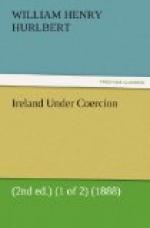We drove near the house of the “beauty of Gweedore,” but she was not visible, though we met her mother (by no means a pulchra mater) as we crossed the Clady at Bryan’s Bridge.
We soon passed from the bogland into a wilderness of granite. Our jarvey, however, maintained that there was “better land among the stones than any bogland could be.” He was a shrewd fellow, and summed up the economical situation, I thought, better than some of his betters, when he said of the whole region that “it will fatten four, feed five, and starve six.”
It may well fatten six, though, I should say, if the natural wealth of this vast granite range can be properly turned to account. On every side of us lay vast blocks of granite of all hues and grades, all absolutely unworked, but surely not unworkable. We stopped and picked up many specimens, some of them almost as rich in colour as porphyry. Of lakes and lakelets supplying water-power the name too, is legion.
Beyond Annagary we caught a glimpse of the Isle of Arran, the scene, a few years ago, of so much suffering, and that of a kind I should think as much beyond the control of legislation as the misery and destruction which have overtaken successive attempts to establish settlements on Anticosti in the Gulf of St. Lawrence.
This town of Dungloe sprawls along the shore of the sea. It is reputed the most ill-favoured town in Donegal, and it certainly is not a dream of beauty. But it blooms all over with evidences of the prosperity of that interesting type of Irish civilisation, the “Gombeen man,” of whom I had heard so much at Gweedore. Over the doorways of most of the shops appear the names of various members of the family of Sweeney, all of them, I am told, brought here and established within a few years past by the head of the sept, who is not only the great “Gombeen man” of the region, but a leading local member of the National League, and Her Majesty’s Postmaster. The Sweeneys, in fact, commercially speaking, dominate Dungloe, their, only visible rivals being a returned Irish American, who has built himself a neat two-story house and shop just at the entrance of the village, and our own host, Mr. Maurice Boyle, whose extremely neat little inn just faces a large shop, the stronghold of the Chief of the Sweeneys. I am sorry to find that this important citizen of Dungloe is not now here. We went into his chief establishment to make some purchases, and found it full of customers, chiefly women, neatly dressed after the Donegal fashion, and busily chaffering with the shopgirls and shopmen, who had their hands full, exhibiting goods such as certainly would not be found in any New York or New England village of this sort. When we secured the attention of the chief shopman, a nattily dressed, dark-haired young man who would not have discredited the largest “store” in Grand Street or the Bowery of New York, we asked him to show us some of the home-made woollen goods of the country. These, he assured us, had no sale in Dungloe, and he did not keep them. But he showed us piles of handsome Scottish tweeds at much higher prices. Now as this is an exclusively agricultural region, it is evident that the tenants must be able to make it worth a trader’s while to keep on hand such goods as we here found, and therefore that they cannot be exactly on “the ragged edge” of things.




